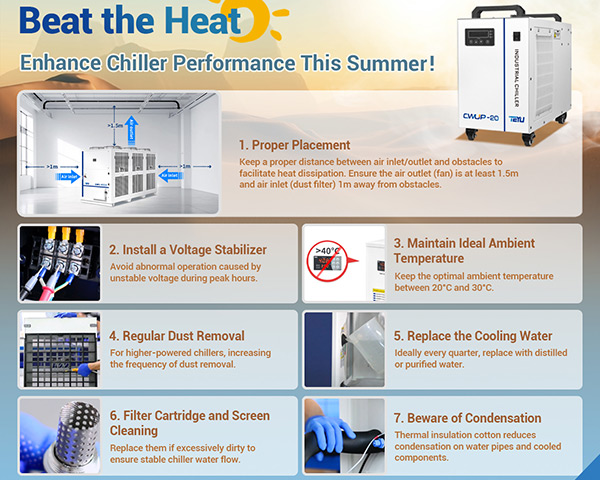如何让您的工业冷水机在炎炎夏日里保持“清凉”并保持稳定的制冷?以下为您提供一些夏季冷水机维护技巧:优化运行条件(如正确放置、稳定供电、保持理想环境温度)、定期维护工业冷水机(如定期除尘、更换冷却水、滤芯及过滤器等)、提高设定水温以减少凝露。
炎热夏季工业冷水机如何保持稳定制冷?
炎炎夏日即将来临!如何让你的工业冷水机“凉快”下来,确保它持续稳定制冷?今天,TEYUS&A工程师团队就来和大家分享一些专家小妙招吧~
1.优化操作条件
正确放置:为保持良好的散热效果,请确保出风口(风扇)距离障碍物至少 1.5 米,进风口(防尘网)距离障碍物至少 1 米。
稳定电压供应:安装稳压器或使用具有稳压功能的电源,有助于避免夏季用电高峰时段因电压不稳定而导致冷水机组运行异常。建议稳压器的功率至少为工业冷水机组电力需求的1.5倍。
保持理想环境温度:如果工业冷水机的运行环境温度超过40°C,可能会触发高温报警并导致工业冷水机停机。为避免这种情况,请将环境温度保持在20°C至30°C之间,这是最佳范围。
如果车间温度较高,影响设备正常使用,可以考虑采用水冷风扇、水帘等物理降温方式降低温度。
2.工业冷水机组的定期维护
定期除尘:定期使用气枪清除工业冷水机除尘网和冷凝器表面的灰尘和杂质。积聚的灰尘会影响散热,甚至可能引发高温报警。(工业冷水机功率越大,除尘频率越高。)注意:使用气枪时,请与冷凝器翅片保持约15cm的安全距离,并垂直向冷凝器吹气。
更换冷却水:定期(最好每季度更换一次)使用蒸馏水或纯净水。同时,请清洁水箱和管道,以防止水质恶化,影响冷却效率和设备寿命。
滤芯和滤网更换:工业冷水机的滤芯和滤网容易积聚污垢,需要定期清洁。如果滤芯和滤网过脏,请及时更换,以确保工业冷水机水流稳定。
3. 注意冷凝
在夏季高温高湿的环境下,如果水温低于环境温度,水管及冷却部件上容易形成凝露,造成电路短路,甚至损坏工业冷水机组的核心部件,影响生产。
建议根据环境条件和激光器使用要求,适当提高设定水温,以减少凝露。
如果您遇到任何冷水机组故障排除问题,请随时联系我们的客户服务团队service@teyuchiller.com。


当您需要我们时,我们会随时为您服务。
请填写表格与我们联系,我们将很乐意为您提供帮助。









































































































